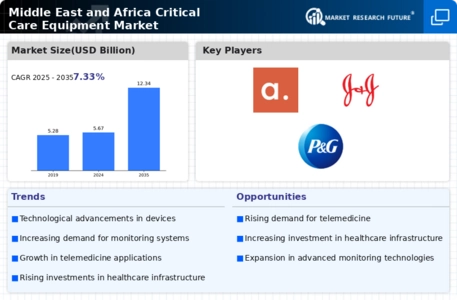Market Share
MEA Critical Care Equipment Market Share Analysis
Technological advancements have been a crucial catalyst for the growth of respiratory care devices, playing a pivotal role in the expansion of the medical ventilator market. The market has witnessed a surge in the development of patient-friendly, cost-effective, and portable medical ventilator devices, further driving its growth trajectory. Notably, innovation in medical ventilators has gained prominence, particularly during the COVID-19 pandemic, where these devices play a vital role in saving lives. In April 2020, significant technological innovations emerged:
India's Ventilator Invention: In India, scientists and neurosurgeons collaborated to create a compact ventilator, the size of a toaster, designed to combat the challenges posed by the coronavirus. Priced at USD 2000, this ventilator efficiently delivers breathable air to patients, contributing to the fight against COVID-19.
Xerox's Disposable Ventilators: Xerox Holdings Corporation announced its commitment to rapidly scale up the production of affordable, disposable ventilators. These ventilators serve as a critical solution to address the shortage of hospital-grade ventilators during the COVID-19 pandemic.
Tesla's Ventilator Initiative: Tesla, the electric vehicle manufacturer, outlined plans to repurpose its extensive inventory of auto parts for the production of ventilators. This initiative aimed to bolster the nation's supply of essential breathing machines during the ongoing health crisis.
RCF's Low-Cost Ventilator Prototype: The Rail Coach Factory (RCF) in Kapurthala, India, a public sector undertaking under the Indian Railway, developed a low-cost ventilator prototype. Designed for use in isolation wards and quarantine facilities set up in train coaches by Indian Railways, this innovation showcased the adaptability of technology in addressing urgent healthcare needs.
As part of market strategies, several key players are focusing on obtaining regulatory approvals and launching new products to fortify their market positions. These initiatives contribute to the overall growth of the medical ventilator market.
In June 2019, the Hamad Medical Corporation (HMC) collaborated with specialists from seven international centers to introduce a revolutionary mechanical ventilation technique named Evone. This technique was implemented for patients undergoing surgery at the hospital, marking a significant milestone in respiratory care.
In May 2020, Indian companies, including Alpha Design Technologies Pvt Ltd, Bharat Forge Ltd, and Medha Servo Drives Pvt Ltd, secured a license from NASA to manufacture indigenously developed ventilators. This licensing agreement aimed to address the critical needs of COVID-19 patients.
On March 31, 2020, Medtronic unveiled the Puritan Bennett (PB) 560 portable ventilator hardware. To meet the surging demand for ventilators during the pandemic, the complete specifications and product manuals were made accessible to the public, facilitating broader access to this vital medical equipment.






Leave a Comment